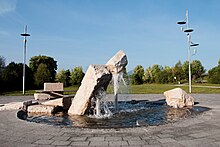Lieferinger village fountain
The Lieferinger Dorfbrunnen is a fountain located in the city of Salzburg and erected in 2005 in the Liefering district on the roof of the Lieferinger tunnel . It is one of 51 city-owned wells.
History and meaning
The formerly independent village of Liefering was cut into two parts from 1939 with the construction of the former Reichsautobahn coming from Germany to Vienna (today Westautobahn ), which was perceived as painful until the end. The population of Liefering, which despite belonging to the city of Salzburg has retained an independent identity since 1939 and calls itself the village within the city , vehemently demanded housing for the motorway in the Liefering area from the 1980s for environmental reasons . As a result, the Liefering Tunnel was completed in 2001, which the local population perceives as a joyful reunification of the village.
When designing the roofing of the tunnel, the wishes of the Liefering population were taken into account, and the covering was largely designed in the form of a leisure area. In addition to the so-called tunnel playground, which was opened in 2004, a fountain was created in 2005, which is subsequently referred to by the locals as a village fountain and is intended to connect to the social function of such as a sociable meeting place. In addition, the newly created free space above the tunnel is repeatedly referred to as the village square .
Design and intent
The Salzburg sculptor Hartwig Rainer Mülleitner (* 1968) was commissioned to design the fountain, who subsequently also designed the rest of the space on the roofing of the Lieferinger Tunnel. Blocks of Untersberg marble measuring around 60 x 60 x 60 cm to 60 x 60 x 230 cm were used as building material. The stones were found in excellent condition at a nearby location in 1996/1997 during construction work. In all likelihood, these are parts from a building from Roman times. The Liefering area has been a populated area since Roman antiquity .
The fountain is in the form of a circular basin lined with granite , from which several of these stone blocks protrude. Three are attached to stainless steel pipes, which are surrounded by a ring of nozzles at the base and sprayed with water. This creates the impression that the stones are being lifted up by the water coming from below, resulting in an interplay of heavy mass and lightness. At night the construction is illuminated from the inside by means of a fiber optic light pipe. More of these stones are placed a short distance around the fountain and used as a substructure for the bench next to it.
- "Path" design concept
A concept that Mülleitner also followed when designing the fountain was the “way”. The idea is based, on the one hand, on the fact that the Roman road Via Julia from Salzburg to Augsburg ran through today's Liefering, which creates a reference to the old stone material. On the other hand, another route, the autobahn, was decisive for the Liefering people for more than half a century. Finally, with the creation of a unified Liefering by bridging the motorway on the tunnel, a new route leads to Liefering. The idea is expressed through a path to the well. Several stones outside the well basin are placed so that they can be seen as access to the well. The loose arrangement of the stones also gives the impression of an ancient street. The way to the fountain or its accessibility is also available insofar as it is not designed to be raised, but can be entered directly without having to overcome an enclosure. Ultimately, unlike many other fountains in the city, the Lieferinger village fountain is not enclosed in winter and remains visible.
swell
Web links
Individual evidence
- ↑ See the explanations regarding the Lieferinger Tunnel .
- ↑ This is also the name of a book publication: Liefering. The Village in the City , ed. from the board of trustees of the Peter Pfenninger donation Liefering, [o. V.] Salzburg 1997.

